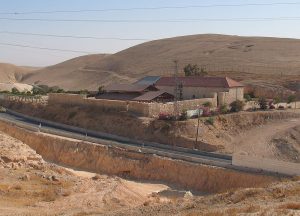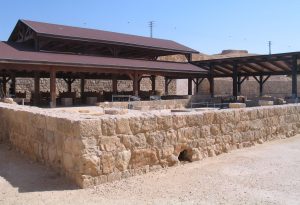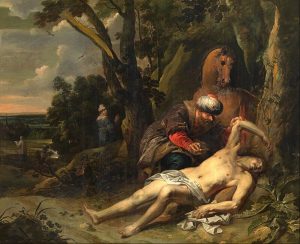On the road from Jerusalem to Jericho stands the Inn of the Good Samaritan: a museum and waystation that houses a fine collection of mosaics from synagogues and churches in Israel and the West Bank, assembled by Yitzhak Magen, a renowned Israeli archaeologist.

The Good Samaritan Museum by Bukvoed
During one of my first visits to the holy places, someone in the group exclaimed in surprise:
– What? I thought the Good Samaritan was a character from one of Jesus’ parables! I didn’t know he actually existed! A lively commotion broke out on the bus. People shared what they knew. Someone looked it up online, and—of course—the conversation veered off in unrelated directions. Whenever I pass by that museum, I remember this anecdote.
Did the Good Samaritan exist or not? No, he did not exist! He is a fictional character in one of Jesus’ most beautiful parables, crafted to answer the question, “Who is my neighbor?”
Yet one might still ask: Are we sure he didn’t exist? Is he merely the masterful invention of an exceptional teacher? Or did Jesus shape his answer from a real event known to him, and perhaps to his audience? Several of his parables highlight everyday events, surely drawn from ordinary life: the woman who turns her house upside down to find a lost coin; the shepherd who carries the injured sheep; the merchant who risks everything to invest in the deal of a lifetime…. The universal power of these teachings lies in their realism and their ability to help us identify with the characters. That is the gift of great storytellers. And Jesus certainly displays that gift.
The Parable of the Good Samaritan (Luke 10:30-37) draws us in; it makes us realize that we all carry within us a good Samaritan, someone capable of responding with compassion and helping whoever is in need: a foreign woman who, on the Sabbath, helps her observant Jewish neighbor by flipping the light switch that her young son had turned off; a motorist who stops to help change a flat tire; a passerby who lifts someone who stumbled while crossing the street… Countless ordinary moments in which both the one needing help and the one providing it is someone, regardless of identity or beliefs.

Byzantine church rebuilt by Bukvoed
The parable reminds us that solidarity, exercised spontaneously and without expecting compensation, is part of who we are, even though haste, prejudice, fear, or disgust sometimes lead us to look away, silencing the inner voice that urges us to attend to anyone in need.

The Good Samaritan (1647), oil on canvas by Balthasar van Cortbemde (1612-1663), shows the Samaritan attending to the wounded man while the Levite and the priest walk away into the distance.
The story of the Good Samaritan — whether made up or real — encourages us to not silence that voice: in this way, the Inn, a place to rest and regain strength, becomes, due also to the innkeeper’s skill, a meeting point, a space of relationships among people. A place where differences and problems can be set aside to help whoever is most in need. And who knows? Perhaps we can also recognize ourselves in that poor, battered man and be grateful for care received, no matter who provides it.
By Carmen Rodríguez Eyré
